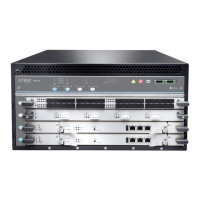To attach a reporting device for the other kind of alarm, repeat the procedure.
Figure 85: Alarm Relay Contacts
Related
Documentation
Connecting DPC, MPC, MIC, or PIC Cables to the MX240 Router on page 217•
• Connecting the Alarm Relay Wires to the MX240 Craft Interface on page 267
Connecting DPC, MPC, MIC, or PIC Cables to the MX240 Router
To connect the DPCs, MPCs, MICs, or PICs to the network (see Figure 86 on page 218 and
Figure 87 on page 218):
1. Have ready a length of the type of cable used by the component. For cable
specifications, see the MX Series Interface Module Reference.
2. Remove the rubber safety plug from the cable connector port.
WARNING: Do not look directly into a fiber-optic transceiver or into the
ends of fiber-optic cables. Fiber-optic transceivers and fiber-optic cable
connected to a transceiver emit laser light that can damage your eyes.
CAUTION: Do not leave a fiber-optic transceiver uncovered except when
inserting or removing cable. The safety cap keeps the port clean and
prevents accidental exposure to laser light.
3. Insert the cable connector into the cable connector port on the faceplate.
NOTE: The XFP cagesand optics onthe components are industry standard
parts that have limited tactile feedback for insertion of optics and fiber.
You need to insert the optics and fiber firmly until the latch is securely in
place.
4. Arrange the cable to prevent it from dislodging or developing stress points. Secure
the cable so that it is not supporting its own weight as it hangs to the floor. Place
excess cable out of the way in a neatly coiled loop.
217Copyright © 2017, Juniper Networks, Inc.
Chapter 18: Connecting the MX240 Router to the Network

